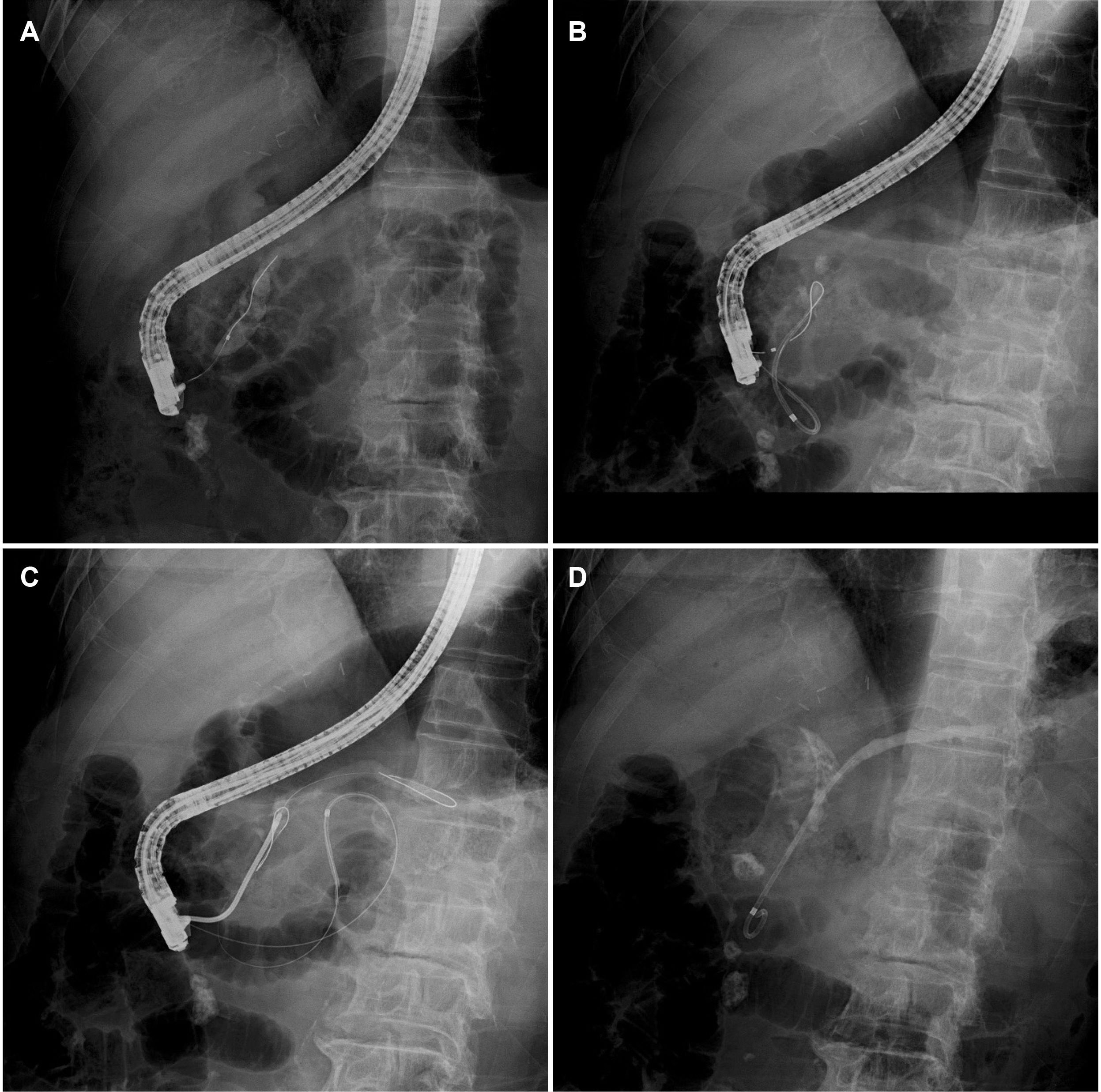Korean J Gastroenterol.
2023 Jan;81(1):36-39. 10.4166/kjg.2022.121.
Guidewire Impaction in the Main Pancreatic Duct in a Patient with Chronic Pancreatitis: A Case Report
- Affiliations
-
- 1Department of Internal Medicine, Ulsan University Hospital, University of Ulsan College of Medicine, Ulsan, Korea
- KMID: 2538686
- DOI: http://doi.org/10.4166/kjg.2022.121
Abstract
- The guidewire is an essential accessory in ERCP. Although rare, guidewires can cause complications, such as subcapsular hepatic hematoma, perforation, knotting, fracture, and impaction, during ERCP. This report describes a guidewire impaction during the endoscopic treatment of a patient with symptomatic chronic pancreatitis. The methods used to treat guidewire impaction are not well known. In the present case, the impacted guidewire was retrieved by inserting another guidewire and dilating the space adjacent to it. Endoscopists should check for the free movement of the guidewire before stent deployment. Additionally, it is important to ask for help from experienced senior staff to overcome any challenges during the procedure. In conclusion, endoscopists should be aware of the possibility of a guidewire impaction during ERCP.
Figure
Reference
-
1. Kwon CI, Koh DH, Song TJ, Park WS, Lee DH, Jeong S. 2020; Technical reports of endoscopic retrograde cholangiopancreatography guidewires on the basis of physical properties. Clin Endosc. 53:65–72. DOI: 10.5946/ce.2019.114. PMID: 31382731. PMCID: PMC7003007.
Article2. Somogyi L, Chuttani R, Croffie J, et al. Technology Assessment Committee. Guidewires for use in GI endoscopy. Gastrointest Endosc. 2007; 65:571–576. DOI: 10.1016/j.gie.2006.10.003. PMID: 17383455.
Article3. Fatima J, Baron TH, Topazian MD, et al. 2007; Pancreaticobiliary and duodenal perforations after periampullary endoscopic procedures: diagnosis and management. Arch Surg. 142:448–455. DOI: 10.1001/archsurg.142.5.448. PMID: 17515486.
Article4. Bhasin DK, Poddar U, Wig JD. 2000; Knot formation in a floppy-tipped guidewire in the common bile duct: an unusual complication of ERCP. Endoscopy. 32:S17.5. Gross G, Kiker D. 2006; Intraductal knot formation in a guidewire during ERCP. Gastrointest Endosc. 64:815–816. DOI: 10.1016/j.gie.2006.05.011. PMID: 17055884.
Article6. Pruitt A, Schutz SM, Baron T, McClendon D, Lang KA. 1998; Fractured hydrophilic guidewire during ERCP: a case series. Gastrointest Endosc. 48:77–80. DOI: 10.1016/S0016-5107(98)70136-1. PMID: 9684672.
Article7. Heinerman M, Mann R, Boeckl O. 1993; An unusual complication in attempted non-surgical treatment of pancreatic bile duct stones. Endoscopy. 25:248–250. DOI: 10.1055/s-2007-1010303. PMID: 8519247.
Article8. Khamaysi I, Hajj E. 2020; Rescuing the rescuer: fractured dormia basket and a second basket rescue technique. Euroasian J Hepatogastroenterol. 10:45–46. DOI: 10.5005/jp-journals-10018-1314. PMID: 32742973. PMCID: PMC7376602.
Article9. Bhati CS, Inston N, Wigmore SJ. 2007; Subcapsular intrahepatic hematoma: an unusual complication of ERCP. Endoscopy. 39 Suppl 1:E150. DOI: 10.1055/s-2007-966241. PMID: 17611897.
Article10. Chi KD, Waxman I. 2004; Subcapsular hepatic hematoma after guide wire injury during endoscopic retrograde cholangiopancreatography: management and review. Endoscopy. 36:1019–1021. DOI: 10.1055/s-2004-825861. PMID: 15520924.
Article11. Zizzo M, Lanaia A, Barbieri I, Zaghi C, Bonilauri S. 2015; Subcapsular hepatic hematoma after endoscopic retrograde cholangiopancreatography: a case report and review of literature. Medicine (Baltimore). 94:e1041. DOI: 10.1097/MD.0000000000001041. PMID: 26131812. PMCID: PMC4504646.12. Igarashi H, Yamashita H, Tsuchiya K, Sugimoto D, Ogata I. 2018; Intrahepatic subcapsular biloma after endoscopic retrograde cholangiopancreatography treated by endoscopic biliary drainage. Clin J Gastroenterol. 11:167–171. DOI: 10.1007/s12328-017-0806-4. PMID: 29188552.
Article13. Pomeranz CB, Wehrli NE, Tyberg A, Belfi LM. 2017; Unusual migration of fractured ERCP guidewire: a case report. Clin Imaging. 43:93–96. DOI: 10.1016/j.clinimag.2017.02.001. PMID: 28273653.
Article14. Steelman VM, Thenuwara K, Shaw C, Shine L. 2019; Unintentionally retained guidewires: a descriptive study of 73 sentinel events. Jt Comm J Qual Patient Saf. 45:81–90. DOI: 10.1016/j.jcjq.2018.08.003. PMID: 30262391.
Article15. Ogura T, Ueno S, Okuda A, et al. 2021; Experimental study of loop shape using 0.025-inch ERCP guidewires (with videos). Endosc Int Open. 9:E427–E437. DOI: 10.1055/a-1319-0915. PMID: 33655046. PMCID: PMC7895657.
Article
- Full Text Links
- Actions
-
Cited
- CITED
-
- Close
- Share
- Similar articles
-
- A Case of Ascarid Chronic Pancreatitis Due to Impaction of Ascaris Lumbricoides into the pancreatic Duct
- A Case of Non-alcoholic Chronic Pancreatitis Showing Characteristic Imaging Features
- A Case of Pancreatic Pseudocyst Resolved by Transpapillary Drainage via the Main Pancreatic Duct
- Update on Endoscopic Management of Main Pancreatic Duct Stones in Chronic Calcific Pancreatitis
- Non-alcoholic duct-destructive chronic pancreatitis: recognition before definitive treatment



